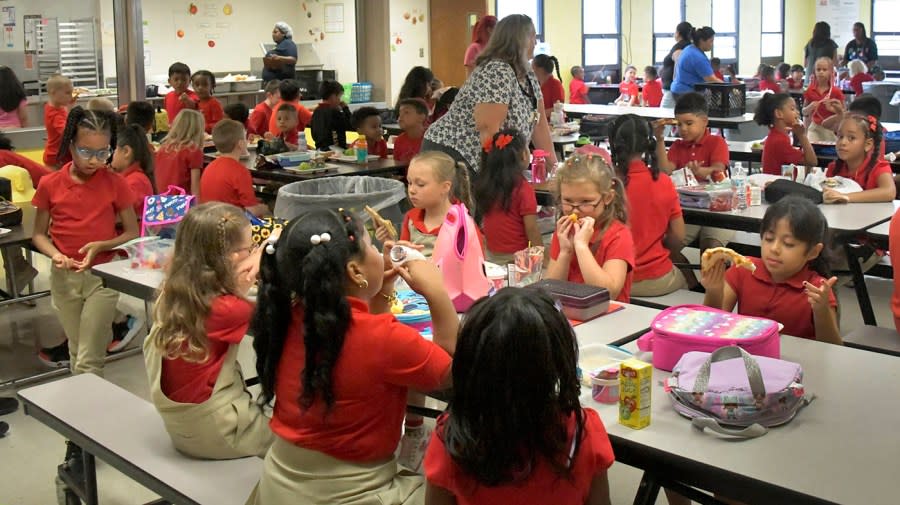A growing number of students rely on free school meals. What happens in the summer?

A growing number of states have implemented free lunches for all students in recent years, making the school year easier for families who are food insecure. But the summer is a different story.
While new federal summer food programs are being cheered by advocates, some states haven’t been able to implement those initiatives, and school officials have been struggling to keep families informed of their options and involved in the process.
States ramped up passing laws for free school meals in 2022 after the end of a national COVID-19 pandemic program that sought to keep students fed.
“Unfortunately, with summertime, all of those resources come to a screeching halt, and that’s when the school gates are locked, millions of youths are locked out of their own reliable source of balanced meals,” said Vince Hall, chief government relations officer for Feeding America.
The U.S. Department of Agriculture (USDA) issued a report last year showing 44.2 million households in the United States had difficulty affording food in 2022, leading 13 million children to live with food insecurity.
The states giving completely free lunches during the academic year include Minnesota, New Mexico, Colorado, Vermont, Michigan, Massachusetts, California and Maine.
“When we feed our children, we’re feeding our future — these investments today will yield benefits tomorrow through generations of healthier New Mexicans,” Gov. Michelle Lujan Grisham (D) said when her state’s measure was passed.
While free school lunch programs are catching fire, there aren’t really parallel programs for the months outside the academic year.
“I’m not aware of states that are providing” free lunches during the school year “that have expanded summer meal options beyond what’s available through the federal program,” said Diane Pratt-Heavner, director of media relations at School Nutrition Association.
Numerous assistance programs are available for families who qualify. According to the nonprofit Food Research and Action Center (FRAC), in 2022, 3 million children were reached through its Summer Nutrition Programs.
And the federal government is launching even more programs this year.
The USDA announced at the beginning of this year it is expanding its summer grocery benefits, affecting 21 million children. The Summer Electronic Benefit Transfer (EBT) will give eligible families a $40-a-month voucher per child for food.
But 15 states, mostly Republican-led, have opted out of the benefit either due to a lack of capabilities to run it or because they reject idea of another federal program on the issue.
“Federal COVID-era cash benefit programs are not sustainable and don’t provide long-term solutions for the issues impacting children and families. An EBT card does nothing to promote nutrition at a time when childhood obesity has become an epidemic,” Iowa Gov. Kim Reynolds (R) said in a statement.
Other states emphasized separate programs they are already enrolled in and insist they are enough.
“To be clear, this does not mean that hungry kids will lose access to summer nutrition programs. Nebraska continues to participate in the existing USDA Summer Food Services Program (SFSB), which best ensures access to nutritious food options and protective services to children who are in need,” said Nebraska Gov. Jim Pillen (R).
Hall, with Feeding America, said he hopes these states will change their minds and is “quite pleased” that more than 70 percent of states are participating this year.
“We believe that the experience of those states will inspire the remaining states to see the tremendous advantages for addressing youth hunger, and then bring the programs home in the following summer,” Hall said.
While advocates are excited over the expansion of free meals, it can fall upon already strained families to keep track.
Pratt-Heavner said in states that have passed free meals for all students, it can be hard to get families to complete applications for summer programs when they receive free lunches throughout the school year with no application process.
“As a result, we have seen, you know, those free and reduced rates decrease, and that does impact area eligibility for summer meal programs,” she said.
Some advocacy groups have created resources to help families know how and when to apply.
“We have been concerned about this,” said Kelsey Boone, senior child nutrition policy analyst at FRAC, adding the summer programs are different from the pandemic programs that allowed students receiving free meals to get other benefits without applying.
“We are aware that this is an outreach issue. This is something where organizations as well as states will need to really be aware of who needs to apply for the program,” Boone said.
“We at FRAC have made a families page … that is directly answering some of those questions and can filter people to their state website so that they know whether or not they need to apply and how to apply. We really encourage states to be very proactive in their outreach and really push the message out that families need to be checking whether or not they will need to fill out an application to receive benefits,” she added.
Copyright 2024 Nexstar Media, Inc. All rights reserved. This material may not be published, broadcast, rewritten, or redistributed.
For the latest news, weather, sports, and streaming video, head to The Hill.

 Yahoo News
Yahoo News 
